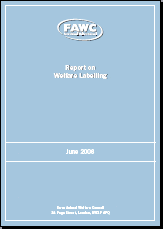
PART VII: THE WAY FORWARD
Labelling on animal welfare grounds has the potential to benefit both consumers and farm animals. Whilst we are strongly supportive of labelling farm animal products we acknowledge that there are a number of unresolved issues that would need significant further attention before any such scheme could be widely implemented, including the following:
Whether international law will permit mandatory rather than voluntary labelling.
If voluntary, whether member states should be required to implement an EU welfare scheme (with criteria based on standardised welfare outcome indicators).
The extent to which labelling based solely on welfare outcome measures at farm level is practicable.
How labelling can aggregate across the different stages of an animals lifetime (e.g. to what extent does an instance of poor transport to slaughter negate a good experience on the farm?).
A variety of labelling schemes can be envisaged. One possibility, along the lines of the present Freedom Food Scheme, is simply to have a stamp of approval indicating high welfare standards. A second approach is to use a tiered system. Such a system might utilise a Bronze, Silver, Gold or a Red, Amber, Green or a 1-5 Star approach. A separate issue is whether a labelling scheme should focus only on animal welfare or be combined with other schemes (Annex 1). A possible advantage of combining welfare labelling with broader considerations, into an overarching assurance scheme, is that consumers would be faced with just a single such label rather than the plethora that are currently developing. However, it may prove difficult to get agreement on such a labelling scheme and the information it contains will necessarily be less precise than that possible if separate schemes continue. Moreover, the issue of equivalence (see para 95) would have to be resolved in some way.
What body should be responsible for administering a welfare labelling scheme? The public may be most trusting of a respected charity even if the scheme is to have government backing.
Whether a welfare labelling scheme would significantly increase the price of animalbased products.
PART VIII: RECOMMENDATIONS
The Government should support the EU Action Plan proposal for an EU welfare label and the development of standardised welfare indicators that allow mandatory and higher welfare standards to be distinguished.
The Government should press at EU level for a single, accredited, mandatory labelling system on animal welfare grounds to be agreed by stakeholders and used for all animalbased products.
In the meantime, the Government should clearly define best practice guidance for all those involved in the food industry and the animal welfare community to stimulate the implementation of welfare labelling of animal-based products, in a clear and consistent manner, as a means of satisfying consumer preferences, enhancing animal welfare and informing the general public.
Welfare labelling should take into account the welfare of individual animals over the entire course of their lives (including pre-birth, on-farm, during transport, at markets and at slaughter). It should be based predominantly on welfare outcomes (i.e. the measurable welfare status of the animals involved in producing the product) rather than on other indicators such as the production system.
Any welfare labelling scheme should be kept as simple as possible both for those who administer it and for those who will use it. Further work should be undertaken to ascertain in what form and how detailed the welfare information provided to consumers should be.
Any welfare-labelling scheme should apply equally to animal-based products produced within the UK and to imported products.
The Government should promote the public procurement of animal-based products which at least meet the UK minimum welfare standards by ensuring that appropriate specifications are included in public procurement training manuals.
Suppliers and buyers should be required to have in place robust and credible assurance schemes, working to clearly defined animal welfare standards, producing unambiguous traceability to farm of origin, with clear enforcement procedures.
The Government should press the WTO to recognise and accept OIE welfare standards and to use them in its disputes procedures.
| Previous Page | Contents | Next Page |
Source: Farm Animal Welfare Council - June 2006
Crown copyright 2006

